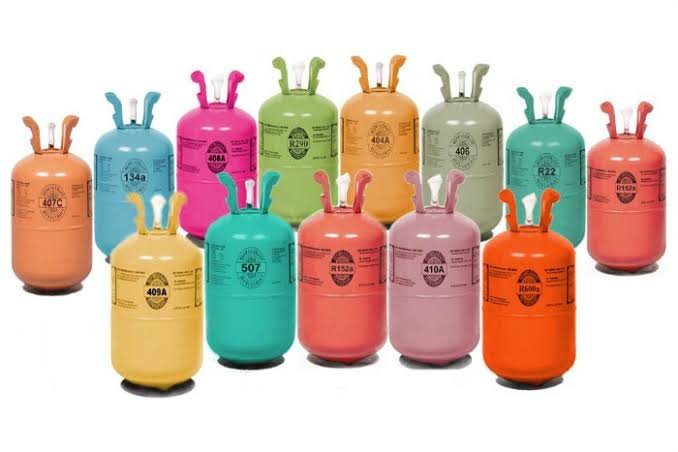
1. R-134a (Tetrafluoroethane)
Pros:
- Non-flammable and non-toxic: Safe for use in various applications.
- Stable and efficient: Good thermal stability and energy efficiency.
Cons:
- Moderate global warming potential (GWP): GWP of 1,430, contributing to global warming.
- Less efficient than newer refrigerants: Not as efficient as some alternative refrigerants.
Costs:
- Moderate cost: Generally affordable, though prices fluctuate based on market conditions.
Environmental Impact:
- Moderate environmental impact: Phased down under global agreements like the Kigali Amendment to the Montreal Protocol due to its GWP.
2. R-404A (Blend of HFC-125, HFC-143a, and HFC-134a)
Pros:
- High efficiency: Suitable for low and medium temperature applications.
- Non-flammable: Safe to handle and use.
Cons:
- High GWP: GWP of 3,922, significantly contributing to global warming.
- Phase-out in progress: Being phased out in many regions due to environmental regulations.
Costs:
- Moderate to high cost: Prices vary, but can be higher due to phase-out and regulatory pressures.
Environmental Impact:
- Significant environmental impact: High GWP leads to strong regulatory pressure to find alternatives.
3. R-410A (Blend of HFC-32 and HFC-125)
Pros:
- High efficiency: Suitable for high-temperature applications.
- Non-flammable: Safe to use in a variety of settings.
Cons:
- High GWP: GWP of 2,088, contributing to global warming.
- Requires specialized equipment: Not compatible with systems designed for other refrigerants.
Costs:
- Moderate cost: Prices are generally affordable but may vary.
Environmental Impact:
- Moderate environmental impact: Phased down under global agreements due to its GWP.
4. Ammonia (NH3)
Pros:
- Zero Ozone Depletion Potential (ODP) and very low GWP: Environmentally friendly.
- High energy efficiency: Excellent thermodynamic properties.
Cons:
- Toxic and flammable: Requires careful handling and stringent safety measures.
- Corrosive: Can be corrosive to certain metals, requiring special materials.
Costs:
- Low cost: Relatively inexpensive compared to synthetic refrigerants.
Environmental Impact:
- Minimal environmental impact: Due to its low GWP and zero ODP.
5. Carbon Dioxide (CO2)
Pros:
- Natural refrigerant: Non-toxic, non-flammable, and environmentally friendly.
- Very low GWP: GWP of 1, making it an excellent alternative from an environmental perspective.
Cons:
- High pressure systems required: Requires robust and expensive equipment to handle high pressures.
- Limited efficiency at high ambient temperatures: Performance can be less efficient in warmer climates.
Costs:
- Moderate to high cost: Initial equipment costs can be high, though operating costs are generally lower.
Environmental Impact:
- Minimal environmental impact: Extremely low GWP and no ODP.
6. R-22 (Chlorodifluoromethane)
Pros:
- Efficient and effective: Widely used in various applications before regulatory restrictions.
- Good thermal properties: High energy efficiency.
Cons:
- High ODP: Significant contributor to ozone depletion.
- Phased out: Production and importation are banned or heavily restricted in many regions.
Costs:
- High cost: Due to phase-out, existing supplies are expensive and diminishing.
Environmental Impact:
- Significant environmental impact: High ODP and GWP, leading to its phase-out under the Montreal Protocol.
In-Depth Content
Composition and Chemical Properties:
- R-134a: Composed of tetrafluoroethane (CH2FCF3). Boiling point: -26.3°C, molecular weight: 102.03 g/mol.
- R-404A: Blend of HFC-125 (44%), HFC-143a (52%), and HFC-134a (4%). Boiling point: -46.5°C.
- R-410A: Blend of HFC-32 (50%) and HFC-125 (50%). Boiling point: -48.5°C.
- Ammonia: Composed of NH3. Boiling point: -33.34°C, molecular weight: 17.03 g/mol.
- CO2: Composed of CO2. Boiling point: -78.5°C, molecular weight: 44.01 g/mol.
- R-22: Composed of chlorodifluoromethane (CHClF2). Boiling point: -40.8°C, molecular weight: 86.47 g/mol.
Summary
The maritime industry utilizes various refrigerants, each with unique benefits and drawbacks. The choice of refrigerant depends on factors such as environmental regulations, efficiency, safety, and cost. While traditional refrigerants like R-22 are being phased out due to their environmental impact, alternatives like ammonia and CO2 are gaining popularity for their low GWP and minimal environmental footprint. Understanding the pros and cons of each refrigerant can help in making informed decisions for maritime refrigeration needs.
for more Maritime learning or to join our forums visit maritimehub.com




